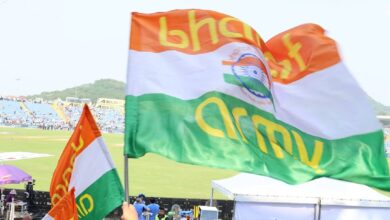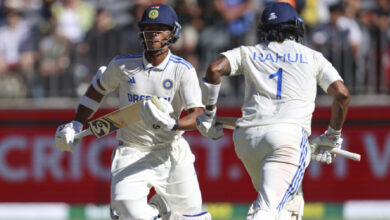India vs England 5th Test: From a rocky field where cattles grazed to a venue of breath-taking beauty — the making of the cricket stadium in Dharamsala | Cricket News

There’s this old hill-lore about the scenic Dharamsala stadium. The narrator is the IPL chairman and Himachal Pradesh’s seasoned cricket adminrator Arun Dhumal. It’s about former Test wicket-keeper Syed Kirmani’s first visit here. While walking past the front porch and the reception area, Kirmani got busy answering a phone call. That is till he reached the stands. It’s when he froze. Dhumal says Kirmani cut the call and exclaimed: “Kya mai jannat mein aa gaya hu? (Have I reached heaven?)”South Africa has Cape Town and the magnificent Table Mountain, Sri Lanka flaunts its horic Galle Fort, New Zealand’s hidden gem is Queenstown next to Lake Wakatipu — all famous for their screen-saver-quality breathtaking beauty. But the competition gets unfair when Dharamsala points to its backdrop — the Himalayas. If stadiums had a beauty pageant, Dharamsala would be the popular choice to get the Miss World crown.
This week, like Kirmani, thousands will cut calls, slump in chairs at the first sight of the landscape-painting like pinkish-red strawberry shade pavilion posing against the prine white backdrop of the imposing Dhauladhar range, a part of the Middle Himalayas.
The 5th India-England Test, starting here from March 7, is a dead rubber but still a large group of fans, stuffed in their cars, will suffer traffic jams and undertake the long uphill trek. After two days of hail and thunderstorm, Monday was a dry day, the fragile sunlight frequently peeping through the crowd.
Despite the weather, for the Test romantics, the pull is too strong to withstand. If the game gets boring, there’s always the snow-capped mountains to brood at — the sight best enjoyed with a cup of hot piping tea and that extra spicy pahadi dhaba- style Maggi. Dharamsala does host IPL games and white-ball cricket but they can’t match the Test experience. What’s cricket at Dharamsala when the Himalayas have a blanket of darkness over it.
The fame of Dharamsala’s beauty has spread wide. Though Bazball has been called out, the away fans have kept their promise, close to 5000 have already reached the venue at 1500 meters height. “Last year when England was here for the World Cup game against Afghanan, the schedule for this Test series was announced. That’s when the Barmy Army executive came to me to tell me that he had started to get calls, English fans are very excited to be here,” says Arun.
Suckers for the game’s oldest format, admirers of small scenic village grounds; for many from England — as cricketer turned journal Michael Atherton mentioned in his recent column — a trip here is a tick mark on their bucket l. Dharamsala, meaning a resting place of pilgrims, continues to live up to its name.
Search for patch of land
Dharamsala didn’t just happen overnight, it took a decade for this landscape to grow into an international facility. It was a project that was delayed because of lack of funds and regional politics. It was pretty much a labour of love for the local cricket association and an architect who believed in subtlety, proportion and blending his creations seamlessly into nature.
The HPCA Stadium ahead in all its glory ahead of the fifth Test between India and England starting Thursday. (Express photo Sandeep Dwivedi)
More than two decades back, the one-time BCCI secretary and present Sports and I&B Miner Anurag Thakur, at 25, was the HP cricket chief. On an extensive state-wide recce in search for a clearing in the hills that could be turned into a cricket ground, he reached Dharamsala.
Arun says his elder brother Anurag, on a hunch, had gone off the beaten path and that’s when he experienced a moment of pure serendipity. In front of him was the breath-taking mountain range and an uneven rocky field next to a college where cattle gathered to graze and students converged with their date. This is it, Anurag would say.
Enter Arun Loomba, a Chandigarh-based architect with experience of designing sports complexes. Today at 71, he has built sports stadiums in Jharkhand, Chhattisgarh, UP and the all-new cricket complex at Mullanpur, Chandigarh.
Back in 1999-2000, Dharamshala was one of Loomba’s early assignments. He was excited but he wasn’t tempted to put together a modern steel and glass structure or an outlandishly asymmetrical stadium complex. Didn’t he think of a Lord’s like press-box? He chuckles. “My first thought was, whatever I design should merge into the site of the stadium, it should gel with nature,” Loomba says.
Not surprisingly, the roof of the pavilion has the shape and colour scheme of the several houses mounted on the rambling hills. The stadium doesn’t shout for attention. In the rural setting, this is no city scraper, more of a vast town square.
Among East India Company’s early conquests in India, Dharamshala is the home of Tibet’s government-in-exile and the seat of the Dalai Lama. The foreign influence that has its stamp on the town’s landscape can be seen at the stadium too. Loomba explains: “The challenge was to create an architectural genre that was colonial, pahari and Tibetan. The north pavilion has roof elements derived from Tibetan Gompas,” he says.
For Arun, it was the case of being true to the “sensibility of the place.”
Loomba stresses the importance of proportion in architecture and how during their brain-storming session they spent a lot of time discussing the height and size of what they built. “Humans have a strong sense of proportion – both good and bad. This stadium design has passed that test,” he says. Nestled in the hills, the stadium neither sticks out like a sore thumb crying for attention nor does the creation get lost in the magical natural surroundings.
Former India captain Virat Kohli fielding in front of the picturesque HPCA Stadium in Dharamsala. (ICC)
Architects are in a way screen-writers. When drawing building plans they also look to add an element of suspense and drama. The approach road to Dharamsala stadium doesn’t prepare you for the jaw-dropping sight that is just minutes away. “The concept was once you enter the stadium, nature should expose itself to you and hit you,” says Loomba. This is an architect of sober sensibilities speaking. Actually, the sight of Dhauladhar hits you like a thunderbolt from the skies.
Early struggle to get big games
After Loomba had painstakingly put together the drawings of the stadiums — AutoCad hadn’t yet reached India — he would realise the difficulties of the project.“Those days the roads were narrow and we were not able to move big machinery. We had to work with smaller machines and manual techniques,” he says. Earth-movers would cry in agony, what with the excavation throwing up giant boulders.
There were also political games. “After the stadium work had started, there was a change in government and there was an effort to take over the association. That actually would be the start of Anurag ji’s political career,” says brother Arun.
Once the stadium started taking shape, other problems cropped up too. Getting big games was still an issue. The place didn’t have quality hotels where teams could stay. “HPCA would then get land from the government on commercial lease to build a hotel, which we would later give to hoteliers Radison to run. There were no flights here also that too was an issue,” says Arun.
A lot has changed since then. Dharamsala is now a top-tour spot with several five-star properties — Taj, ITC and Hyatt. It also has one of the busiest airports in the state.
Even when there is no game, tours flock to the stadium that they have longingly watched on their television screens. Youtube is flooded with amateur vlogs recorded on shaky cameras awestruck tours who manage cliches like “adbhut nazara”, “kudrat ka ajuba” and “dharti pe swarg” to describe their Kirmani moment. “Every day we have footfall of close to 3000 to 4000. We have now plans to come up with a museum and eateries,” says Arun.
Loomba also has ideas about developing the stadium. They are grand. He dreams of building a revolving restaurant where over lunch from starter to dessert one can get a 360 view of “heaven.” Back in the day, he had made a proposal to light up Himalayas for match days and with D-H-A-R-A-M-S-H-A-L-A written on Dhauladhar like H-O-L-L-Y-W-O-O-D on Mount Lee.
Inzamam’s special birthday
Along with its captivating landscape, it’s the warmth and hospitality of the hill-folks that add to Dharamsala’s USP. Last year, New Zealand during the World Cup had Dharamsala as their base camp. During the stay they were sighted in remote villages interacting with the locals and exploring the hills.
“Rachin (Ravindra) told me he was bowled over the beautiful place and wanted to be here when he next visits India. Then there was the England team. They too were here. After their game, they were at the bar till 5 a.m, after that they would go for a trek, and after that straight to the airport,” says Arun.
But there happens to be one cricketer who can never forget this venue. In 2005, Dharamsala hosted a Pakan vs Board President XI tour game. Those were the days when the venue had rudimentary facilities. Shahid Afridi reportedly told the locals – “How to play cricket here. Bus idhar chai piyo aur vaadiyan dekho.”
The moodiest of the lot, skipper Inzamam ul Haq too had complained about the hotel. This was the first week of March and the time of the Pakan great’s birthday. In an inspired move, the Himachal officials thought of making the day memorable for the tours.
“We got a cake and made Inzamam cut it. We also ordered 10,000 laddoos and dributed them to everyone. I still remember Inzamam was so touched the gesture, he leaned towards Anurag ji and was in tears. He got very emotional,” says Arun. “He said ‘Aisa birthday toh Pakan mai bhi nahi manaate’ I will always remember this,” he said.
Dharamsala gets you at hello and gives a lifetime of memories.







